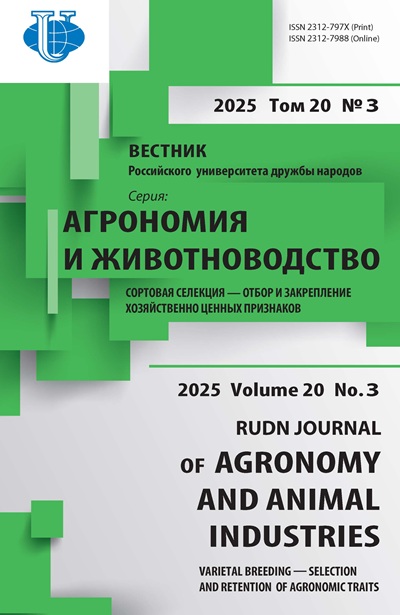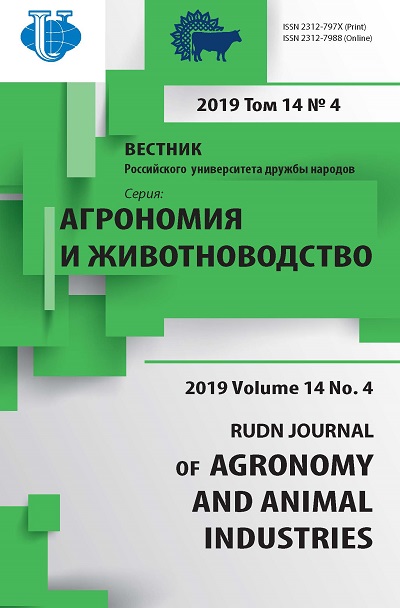Продовольственная безопасность и ведение устойчивого сельского хозяйства с учетом изменения климата в Китае
- Авторы: Шахраджабиан М.Х.1,2, Сунь В.1,2, Чэн Ц.1,2
-
Учреждения:
- Научно-исследовательский институт биотехнологии, Китайская академия сельскохозяйственных наук
- Лаборатория фиксации азота, Институт Ци
- Выпуск: Том 14, № 4 (2019)
- Страницы: 423-429
- Раздел: Защита растений
- URL: https://agrojournal.rudn.ru/agronomy/article/view/19527
- DOI: https://doi.org/10.22363/2312-797X-2019-14-4-423-429
- ID: 19527
Цитировать
Полный текст
Аннотация
Приведен краткий обзор исследований климатических изменений и их негативного влияния на растениеводство в регионах Китая. Повышение показателей средней температуры в течение сезона может повлиять на продолжительность вегетации многих культур, вызвав тем самым снижение урожайности. В северной части Китая увеличится продолжительность вегетационного периода у одних культур и сократится у других. Кроме того, изменения коснутся и количества осадков, увлажненности почв, распространения опасных вредителей и сорняков. Результаты анализа исследований обосновывают необходимость разработки жаростойких и засухоустойчивых высокопродуктивных сортов и сортов, способных обеспечить продовольственную безопасность страны. Рекомендуется адаптировать фермерские хозяйства к стратегиям, объединяющим традиционный опыт и знания коренных народов с научными исследованиями и государственной политикой, в качестве ключевого фактора успешного преодоления неблагоприятных последствий изменения климата. Отмечена важнейшая роль сотрудничества всех стран в целях значительного сокращения выбросов парниковых газов.
Ключевые слова
Об авторах
Мохамад Хесам Шахраджабиан
Научно-исследовательский институт биотехнологии, Китайская академия сельскохозяйственных наук; Лаборатория фиксации азота, Институт Ци
Email: hesamshahrajabian@gmail.com
доктор философии Пекин, Китай; Чжэцзян, Китай
Вэньли Сунь
Научно-исследовательский институт биотехнологии, Китайская академия сельскохозяйственных наук; Лаборатория фиксации азота, Институт Ци
Email: chengqi@caas.cn
Пекин, Китай; Чжэцзян, Китай
Ци Чэн
Научно-исследовательский институт биотехнологии, Китайская академия сельскохозяйственных наук; Лаборатория фиксации азота, Институт Ци
Email: chengqi@caas.cn
доктор философии Пекин, Китай; Чжэцзян, Китай
Список литературы
- Li X, Takahashi T, Suzuki N, Kaiser HM. Impact of climate change on maize production in Northeast and Southwest China and risk mitigation strategies. APCBEE Procedia. 2014; 8:11-20. doi: 10.1016/j.apcbee.2014.01.073
- Chen Y, Zhang Z, Tao F. Impacts of climate change and climate extremes on major crops productivity in China at a global warming of 1.5 and 2.0 °С. Earth System Dynamics. 2018; 9(2):543-562. doi: 10.5194/esd-9-543-2018
- Tao F, Zhang Z. Climate change, wheat productivity and water use in the North China Plain: A new super-ensemble-based probabilistic projection. Agricultural and Forest Meteorology. 2013; 170:146-165. doi: 10.1016/j.agrformet.2011.10.003
- Zhuo L, Mekonnen MM, Hoekstra AY. Consumptive water footprint and virtual water trade scenarios for Chinawith a focus on crop production, consumption and trade. Environment International. 2016; 94:211-223. doi: 10.1016/j.envint.2016.05.019
- Wang JX, Huang JK, Yang J. (2014). Overview of impacts of climate change and adaptation in China’s agriculture. Journal of Integrative Agriculture. 2014; 13(1):1-17. doi: 10.1016/s20953119(13)60588-2
- Li X, Philp J, Cremades R, Roberts A, He L, Li L, Yu Q. Agricultural vulnerability over the Chinese Loess Plateau in response to climate change: Exposure, sensitivity, and adaptive capacity. The Royal Swedish Academy of Sciences. 2015; 45(3):350-360. doi: 10.1007/s13280015-0727-8
- Jiahua P, Yan Z, Markandya A. Adaptation approaches to climate change in China: an operational framework. Economia Agraria y Recursos Naturales. 2011; 11(1):99-112. doi: 10.7201/earn.2011.01.05
- Li Z, Tan J, Tang P, Chen H, Zhang I, Liu H, Wu W, Tang H, Yang P, Liu Z. Spatial distribution of maize in response to climate change in northeast China during 1980-2010. Journal of Geographical Sciences. 2016; 26(1):3-14. doi: 10.1007/s11442-016-1250-y
- Yan T, Wang J, Huang J, Xie W, Zhu T. The impacts of climate change on irrigation and crop production in Northeast China and implications for energy use and GHG emission. Proc. IAHS. 2018; 379:301-311. doi: 10.5194/piahs-379-301-2018
- Chen S, Chen X, Xu J. Impacts of climate change on agriculture: Evidence from China. Journal of Environmental Economics and Management. 2016; 76:105-124. doi: 10.1016/j.jeem.2015.01.005
- Wang Z, Shi P, Zhang Z, Meng Y, Luan Y, Wang J. Separating out the influence of climatic trend, fluctuations, and extreme events on crop yield: A case study in Hunan Province, China. Clim. Dyn. 2018; 51(11-12):4469-4487. doi: 10.1007/s00382-017-3831-6
- Kang H, Seely B, Wang G, Cai Y, Innes J, Zheng D, Chen P, Wang T. Simulating the impact of climate change on the growth of Chinese fir plantations in Fujian province, China. New Zealand Journal of Forestry Science. 2017; 47:20. doi: 10.1186/s40490-017-0102-6
- Guo J, Zhao J, Yuan B, Ye M. Evaluation of agricultural climatic resource utilization during spring maize cultivation in Northeast China under climate change. Acta Meteorologica Sinica. 2013; 27(5):758-768. doi: 10.1007/s13351-013-0508-x
- Guo J, Zhao J, Wu D, Mu J, Xu Y. Attribution of maize yield increase in China to climate change and technological advancement between 1980 and 2010. Journal of Meteorological Research. 2014; 28(6):1168-1181. doi: 10.1007/s13351-014-4002-x
- Yu Y, Zhang W, Huang Y. Impact assessment of climate change, carbon dioxide fertilization and constant growing season on rice yields in China. Climatic Change. 2014; 124(4):763-775. doi: 10.1007/s10584-014-1129-9
- Shahrajabian MH, Wenli S, Qi C. The power of natural Chinese medicine, ginger and ginseng root in an organic life. Middle-East Journal of Scientific Research. 2019; 27(1):64-71. doi: 10.5829/idosi.mejsr.2019.64.71
- Shahrajabian MH, Wenli S, Qi C. A review of goji berry (Lycium barbarum) in traditional Chinese medicine as a promising organic superfood and superfruit in modern industry. Academia Journal of Medicinal Plant. 2018; 6(12): 437-445. doi: 10.15413/ajmp.2018.0186
- Shahrajabian MH, Soleymani A, Ogbaji PO, Xue X. Impact of different irrigation managements on soil water consumption, grain yield, seed protein, phosphorus and potassium of winter wheat. Cercetari Agronomice in Moldova. 2017; 50(3):5-13. doi: 10.1515/cerce-2017-0021
- Shahrajabian MH, Soleymani A. A lysimeter study, a unique tool for botanists, agronomists and other plant scientists. Asian Research Journal of Agriculture. 2017; 4(2):1-9. doi: 10.9734/ARJA/2017/32492
- Shahrajabian MH, Soleymani A, Ogbaji PO, Xue X. Survey on qualitative and quantitative traits of winter wheat under different irrigation treatments using weighing lysimeter in north China plain. International Journal of Plant & Soil Science. 2017; 15(4):1-11. doi: 10.9734/IJPSS/2017/32778
- Ogbaji PO, Shahrajabian MH, Xue X. Changes in germination and primarily growth of three cultivars of tomato under diatomite and soil materials in auto-irrigation system. International Journal of Biology. 2013; 5(3):80-84. doi: 10.5539/ijb.v5n3p80
- Shahrajabian MH, Xue X, Soleymani A, Ogbaji PO, Hu Y. Evaluation of physiological indices of winter wheat under different irrigation treatments using weighing lysimeter. International Journal of Farming and Allied Sciences. 2013; 2(24):1192-1197.
- Shahrajabian MH, Sun W, Cheng Q. The influence of traditional Iranian and Chinese medicine on western and Islamic countries. Asian Journal of Medical and Biological Research. 2019; 5(2):94-99. doi: 10.3329/ajmbr.v5i2.42490
- Shahrajabian MH, Sun W, Cheng Q. Clinical aspects and health benefits of ginger (Zingiber officinale) in both traditional Chinese medicine and modern industry. Acta Agriculturae Scandinavica, Section B-Soil & Plant Science. 2019; 69(6):546-556. doi: 10.1080/09064710.2019.1606930
- Shahrajabian MH, Sun W, Cheng Q. A review of ginseng species in different regions as a multipurpose herb in traditional Chinese medicine, modern herbology and pharmacological science. Journal of Medicinal Plants Research. 2019; 13(10):213-226. doi: 10.5897/JMPR2019.6731
- Shahrajabian MH, Sun W, Cheng Q. Modern pharmacological actions of Longan fruits and their usages in traditional herbal remedies. Journal of Medicinal Plants Studies. 2019; 7(4):179-185.
Дополнительные файлы















